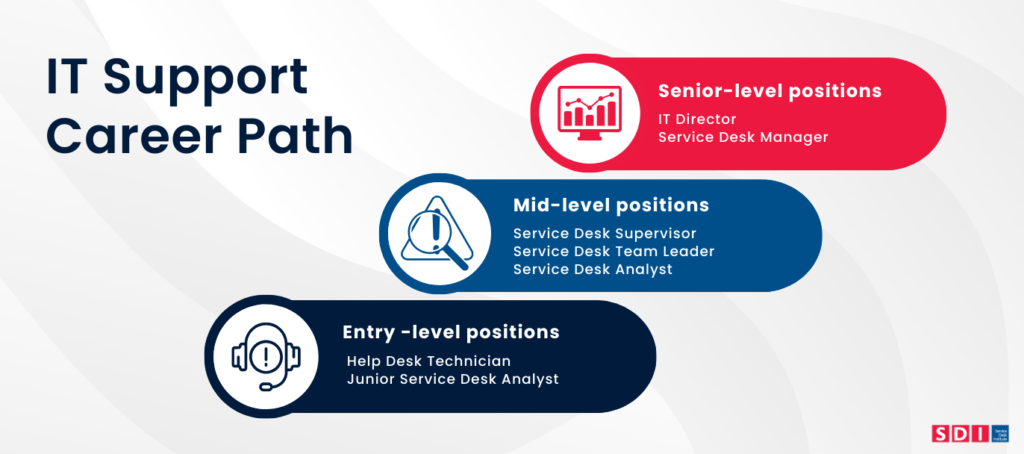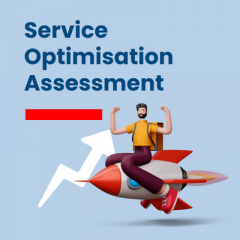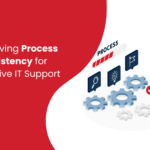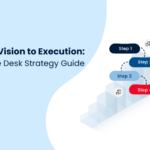
If you want to enter the tech industry, IT support is a great place to start—and a very popular choice. IT professionals are often in high demand due to the role of technology in modern society and the existing gap between the demand for qualified IT workers and the supply.
📊 According to the US Bureau of Labor Statistics, there are approximately 377,500 projected job openings in IT annually.
And the best thing is that you can start in an entry-level role even if you have little experience. But you do have to show basic IT understanding and relevant soft skills. The IT field offers diverse career paths across different industries.
For example, your path as an IT Support professional depends on your personal development speed, self-motivation, and ability to demonstrate necessary skills.
But where do you start? What could be the next step in your IT support career?
We know the options can seem daunting, whether you’re just starting out in IT support or looking to progress in your career. But don’t worry—we’re here to guide you.
In this blog, we’ll explore different IT service desk jobs, their responsibilities, necessary skills, and average salaries.
So, let’s dive in!
How do you start your career in IT support?
Before we explore different levels of IT support jobs, let’s see what’s usually required to start (or advance) your career in IT support. To work in this industry, you often need to have a combination of education, practical experience, and certification.
While a formal degree isn’t always necessary, many employers prefer candidates with at least a bachelor’s degree in computer science, information technology, or a related field.
What are the must-have skills for IT roles?

Let’s explore some basic skills required to enter and effectively perform in IT roles.
Firstly, you will have to possess technical skills or a solid understanding of computer systems, networks, and hardware. Proficiency in operating systems such as Windows, Linux, and macOS is beneficial. But being well-versed in troubleshooting techniques and diagnostic tools is crucial for effectively resolving IT issues.
Then, it’s not always a requirement for all levels of support, but it’s good to have the basic ability to read or write code. As you progress to higher levels of IT support or specialise in certain areas like software development support or automation, coding knowledge may become increasingly valuable. For example, for a developer position, these skills could include knowing Java, C, C++, C# or Java Script. Or knowing some of the script languages like Python that could be highly valuable on higher support levels.
When it comes to IT support, technical skills are not the only ones that matter.
💡 Soft skills are just as necessary, even if they’re not the first thing that comes to mind. So, don’t overlook the importance of having soft skills.
Think about skills such as strong communication skills, the ability to explain technical information in non-technical terms, problem-solving, critical thinking, attention to detail, and patience.
Another important thing to remember is that the technology landscape is constantly evolving, so continuous learning and staying updated on the latest trends, tools, and techniques is essential.
To help you stay competitive in this field, you can choose to participate in workshops, attend conferences, look at qualifications and find training options. IT Certifications are not always mandatory, but they can significantly enhance your employability and credibility in this field.
📢 Discover your next career move – Explore IT Service Desk Jobs Board
Exploring career paths in IT support

Now, let’s explore the most common career paths in IT support. The job titles can differ based on organisation and opportunities for growth and specialisation, but these are considered typical career paths in IT support.
Here’s a list of positions, from entry-level to senior level, along with their responsibilities, expected salaries, and required skills.
Entry-Level Positions
Junior Service Desk Analyst
This entry-level role is great for individuals who want to gain experience by providing technical support to end-users within the organisation. This role might seem very similar to the Help Desk Technician (mentioned below), and there is often an overlap. But these roles are often differentiated by their technical complexity, autonomy, and level of customer interaction.
Some responsibilities include:
- The primary responsibility is to ensure efficient and uninterrupted workflow.
- Receiving and logging incoming support requests via phone, email, or ticketing system.
- Assisting with password resets, software installations, and basic hardware issues.
- Ensuring a timely resolution in line with SLA & Service Desk processes.
- Escalating more complex issues to senior analysts or other appropriate IT teams.
- Creating and updating knowledge base articles to aid in issue resolution.
Reports to: Service Desk Analyst, Service Desk Team Lead /Supervisor or SDM
Average annual salary:
- United Kingdom – £22,500 (Talent.com)
- United States – $50,508 (Indeed.com)
Help Desk Technician
Help desk technicians are usually responsible for handling more complex technical issues than junior service desk analysts. This includes resolving hardware problems, configuring network settings, and troubleshooting complex software issues.
Some responsibilities include:
- Managing tickets through a tracking system. This involves logging issues and updating ticket statuses.
- Providing on-site support, physically interacting with hardware, and directly resolving issues.
- Doing regular maintenance checks and system updates and ensuring all IT equipment complies with company policies and standards.
- Maintaining basic IT security practices.
- Providing training sessions or creating instructional materials on how to use new software and hardware effectively.
Reports to: Service Desk Supervisor, Service Desk Manager
Average annual salary:
- United Kingdom – £25,000 (Talent.com)
- United States – $53,414 (Indeed.com)
⚡ Tips for starting a career in IT support:
✅ It’s always good to start with the basics. For example, you can focus on foundational certifications like CompTIA A+, that’s widely recognised in the industry.
✅ To gain practical experience, look for internships, volunteer opportunities, or trainee positions. This will help you develop your skills and apply your knowledge in real-world settings.
✅ Think about joining IT forums and connecting with professionals to learn more about new technologies and job opportunities. Attending industry conferences such as Spark, The Service Desk & IT Support Show (SITS), ITSX Summit or a similar event is a great way to do so.
✅ Once you have a general understanding of IT support, it’s always good to think about your career goals. So, consider different areas you would like to specialise in to enhance your career progression.
Mid-level positions
Service Desk Analyst
This role is for individuals with more extensive experience handling complex issues and mentoring junior analysts. As a Service Desk Analyst, your main responsibility will be to be the central contact for all IT-related issues and incidents and to offer exceptional support across a range of products and services.
Some responsibilities include:
- Acting as a single point of contact for client escalations.
- Ensuring timely resolution of critical incidents.
- Ensuring that information is accurately recorded in the service management tool.
- Ensuring that incidents are assigned to the correct escalation or resolution team.
- Handling Service Desk calls within agreed service level agreements (SLAs).
- Providing basic in-house training to customers.
- Sharing technical expertise within the team.
- Conduct in-depth root cause analysis to prevent recurring issues and optimise systems.
- Identifying potential areas for improvement.
Reports to: Service Desk Team Leader
Average annual salary:
- United Kingdom (SDI Service Desk Benchmarking 2024)
- Starting salary – £22,500
- After 2 years – £27,120
- United States – $62,645 (Indeed.com)
Service Desk Team Leader
In this position, you will lead and guide your team to provide excellent customer service and resolve customer issues quickly. As a team leader, you will have to ensure service goals are met and client expectations are exceeded.
Some responsibilities include:
- Supervising and coordinating the daily activities of the Service Desk team.
- Assisting in resolving complex technical issues.
- Providing coaching and training to team members.
- Assisting in recruiting, onboarding, and training new service desk analysts.
- Conducting regular team meetings to provide updates, share knowledge, and address team concerns.
- Collaborating with IT managers and senior leaders.
- Generating reports and analysing service desk performance metrics to track KPIs.
Reports to: Service Desk Manager or IT Service Delivery Manager
Average annual salary:
- United Kingdom – £33,683 (Glassdoor.co.uk)
- United States – $61,389 (Salary.com)
Service Desk Supervisor
This position involves overseeing the service desk team, ensuring efficient operation, and maintaining high levels of customer satisfaction. This means that as a Service Desk Supervisor, your responsibility will be to ensure the smooth operation of service desks.
Some responsibilities include:
- Ensuring that the service desk operations run smoothly on a daily basis.
- Leading a team of service desk analysts or IT support staff.
- Ensuring that service levels are met, and a positive user experience is maintained.
- Overseeing the general progress of communication and handling any unexpected events that may arise.
- Acting as a representative of the service desk team in broader IT and business discussions.
Average annual salary:
- United Kingdom (SDI Service Desk Benchmarking 2024)
- Starting salary – £31,600
- After 2 years – £35,000
- United States – $83,640 (Salary.com)
⚡ Tips for advancing to senior positions in IT Support
✅ If you want to move to senior positions, you might want to consider some courses in IT service management or leadership to enhance your leadership skills.
✅ Experience in leading small projects or mentoring junior staff can also be beneficial for developing your management and leadership skills. Phill Collins perfectly captures the relationship between learning and teaching in his lyrics: “In learning you will teach, and in teaching you will learn.”
✅ Get more familiar with some data analysis tools and techniques, as interpreting data to make informed decisions is quite important for senior positions.
✅ Don’t be afraid to ask for feedback from colleagues and supervisors to build a strong case for your advancement.
✅ It’s always good to consult with your peers regularly and ask for their guidance or advice. This can help you gain valuable insights and perspectives.
✅ Take some time to reflect on your career path and adjust your goals and strategies as needed. This will help you stay motivated and satisfied with your job.
Senior-level positions
Service Desk Manager
As a senior-level position, service desk managers are responsible for managing the entire service desk operation, including staff management, strategic planning, and ensuring alignment with business objectives. This includes identifying cost savings and profitability areas while delivering top-level support and service excellence.
Some responsibilities include:
- Leading, mentoring, and developing a team of service desk analysts and team leaders.
- Overseeing the day-to-day operation of the Service Desk, including workload distribution.
- Helping with complex technical issues and client escalations.
- Building and maintaining relationships with key stakeholders and clients.
- Reporting on service desk performance and improvements to senior management.
- Develop and implement service desk strategies.
- Manage staffing, resource allocation, and budgeting for the service desk team.
Reports to: IT Service Delivery Manager or IT Director
Average annual salary:
United Kingdom – £44,982 (Talent.com)
- United States – $86,357 (Indeed.com)
Information Technology Director (IT Director)
This top-tier position includes individuals responsible for the overall planning, organising, and executing all IT functions.
Some responsibilities include:
- Developing and implementing IT strategies that align with the organisation’s objectives.
- Overseeing the IT department’s staff, strategy, and overall operations.
- Overseeing the technological infrastructure in the organisation to ensure optimal performance.
- Managing IT risks by analysing data.
- Developing and controlling the IT budget to support the organisation’s strategic objectives.
Reports to: Chief Executive Officer (CEO) or the Chief Operating Officer (COO)
Average annual salary:
- United Kingdom – £75,000 (Talent.com)
- United States – $130,894 (Indeed.com)
Guide to choosing the right SDI training qualification

Nobody wants to be THAT service desk manager who’s failing to provide support, resources, and tools their team needs. Or service desk analyst who’s making avoidable mistakes by ignoring documentation. That’s why training and development in IT and ITSM are absolutely crucial.
Not only for individual professionals who want to enhance their skills but also for the performance and satisfaction of the entire team. At SDI, we offer training courses and development workshops tailored to meet the needs of any IT service professionals.
Our goal? It’s simple: every one of our courses is designed to inspire service desks to achieve excellence and provide industry best practices.
Not sure whether these courses are suitable for you?
Here are some of the available training courses, along with their details:
Service Desk Analyst (SDA) Training
🎯 Objective: This course aims to provide you with an in-depth understanding of the SDA Professional Standard. This course is ideal for developing in this role as it ensures that you understand the purpose and responsibilities of a service desk analyst position.
⚡Benefits: You will learn best practices in communication, support processes, and managing and resolving customer queries effectively. We always say that this course is essential for anyone looking to excel as a service desk analyst.
Service Desk Manager (SDM) Training
🎯 Objective: This course is designed for any current or aspiring service desk managers. It focuses on equipping you with the skills needed to manage a service desk effectively. It covers strategic planning, leadership, and operational management.
⚡ Benefits: You will learn how to improve service desk operations, enhance team performance, and align service desk goals with organisational objectives.
ITSM Best Practices Training
🎯 Objective: This course offers insights into the best practices in IT Service Management. It covers frameworks and standards such as ITIL® (Information Technology Infrastructure Library), which is crucial for managing IT services effectively.
⚡Benefits: You will learn to implement and manage ITSM processes according to globally recognised best practices. This is very beneficial for improving IT services and customer satisfaction.
Customised Workshops
🎯 Objective: We know that you may have unique training needs. That’s why we designed these customised workshops. How do they work? They are tailored to the specific needs of your service desk team or organisation. We want to help you provide the best possible training for your team, so we can cover various topics, from operational efficiency to customer service excellence.
⚡Benefits: You can receive tailored training that addresses your team’s unique challenges and goals, leading to more effective and cohesive service desk operations.
This is the secret weapon to your IT career success…
So, what is the secret weapon?
Well, the truth is, it’s not really a secret at all! It’s quite simple. If you’re looking to build a successful career in IT, investing in training and development is the KEY. Whether you’re in an entry-level position and just starting out or aiming for senior leadership roles, there’s a path to success for everyone in IT support.
Learning and staying up to date with the latest trends and best practices is the way to go.
If you need help, guidance, or motivation regarding your next career path, feel free to contact our recruitment experts for a chat!

Antonija Bozickovic
Content Marketing Specialist at SDI





























